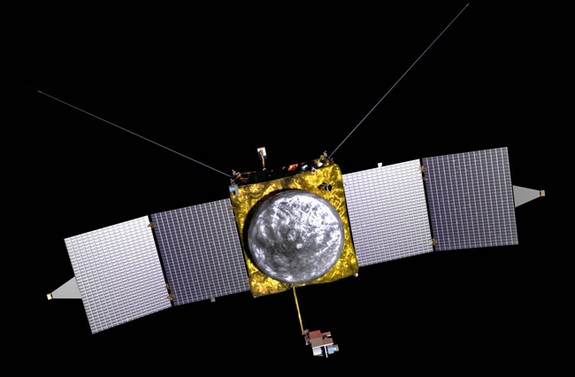Mars MAVEN Arrives At Kennedy Space Center For Launch Prep
This article is more than 2 years old
 If you saw the 55th anniversary infographic of NASA’s planned missions through 2030, you will have already heard about MAVEN, the Mars Atmosphere and Volatile Evolution spacecraft.
If you saw the 55th anniversary infographic of NASA’s planned missions through 2030, you will have already heard about MAVEN, the Mars Atmosphere and Volatile Evolution spacecraft.
Scheduled for launch in November 2013, MAVEN was transported in a metal shipping container from Buckley Air Force Base in Colorado to NASA’s Kennedy Space Center in Florida last week to undergo final preparations. I wonder what the shipping charges were?
NASA has been involved in a number of Mars missions lately, including the Curiosity rover, which just celebrated its one-year anniversary on the red planet. While MAVEN’s goal isn’t to gather evidence of the existence of life on Mars, it will be picking up on some of the work Curiosity has done with regards to Mars’ atmosphere, which appears to have depleted drastically over time. MAVEN will attempt to measure how much of the Martian atmosphere has disappeared into space and at what speed. Scientists will attempt to use the data gathered to piece together a backward reconstruction of the atmosphere that will help them figure out the exact processes that caused the atmospheric changes.
Then, MAVEN will try to determine how the loss of atmosphere affected the Martian climate and what impact it had on the loss of water that was once on Mars’ surface. Ultimately, scientists hope that the $670 million MAVEN mission will unlock a more comprehensive picture of Mars’ climate change over time, which has left the red planet barren.
Scientists at Kennedy Space Center’s Payload Hazardous Servicing Facility have secured MAVEN to a rotation fixture in a clean room and are testing its software, spin balance, deployment of solar panels and booms, and fueling processes before it makes the move to the launch pad. The launch period for MAVEN officially opens on November 18 and has a window of 20 days. MAVEN is expected to enter Mars’ orbit around September 2014 and to remain for a year.
Guy Beutelschies, MAVEN program manager at Lockheed Martin, said in a statement, “It’s similar to moving your children to college after high school graduation. You’re proud of the hard work to get to this point, but you know they still need some help before they’re ready to be on their own.”
Looking at these photos renews that old desire to be an astronaut, or at least an astrophysicist or aeronautical engineer. Can you imagine working on something that will be uncovering the secrets of another planet in a year’s time? I wonder how many of these workers won’t be able to resist carving their initials somewhere on MAVEN. MAVEN Foreva!
















